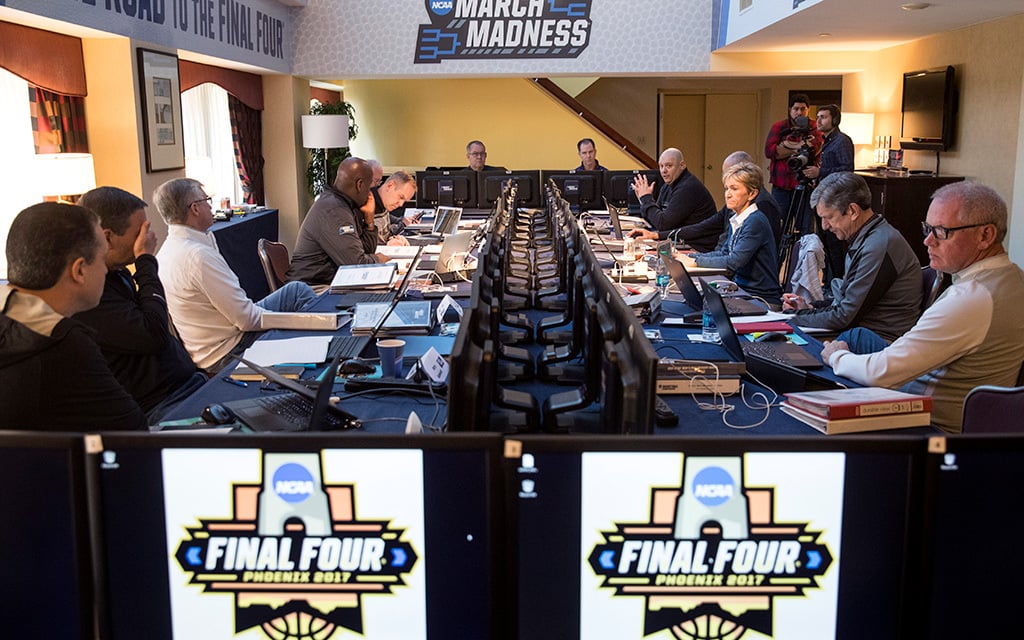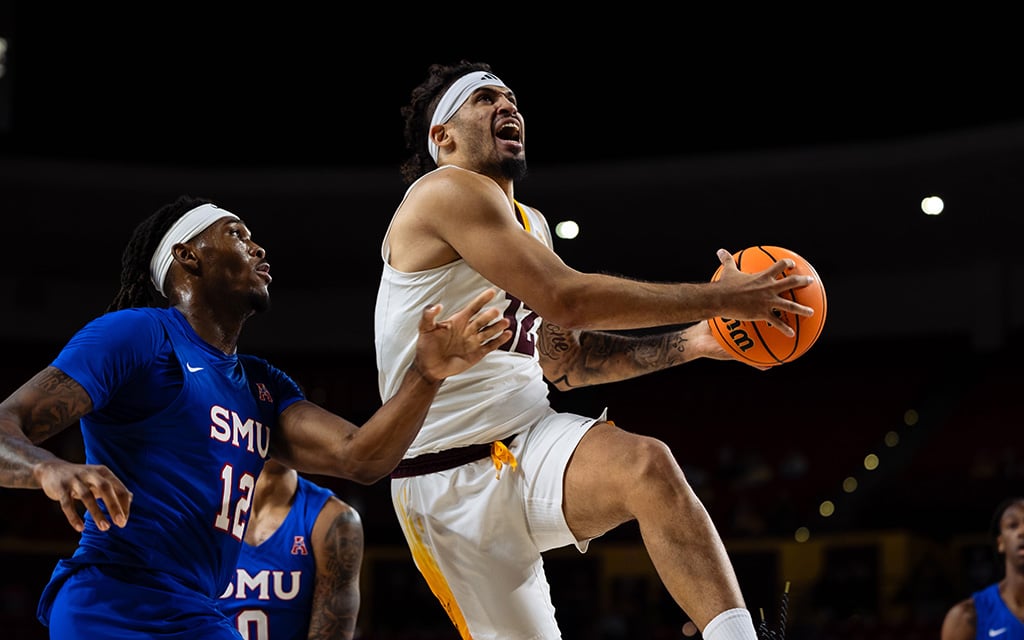
The NCAA Basketball Tournament Selection Committee meets in New York ahead of Selection Sunday to begin the process of selecting and seeding the field of 68 teams. (Photo by Drew Angerer/Getty Images)
PHOENIX – The busiest day of the year for the NCAA Division I Men’s Basketball tournament’s media coordinator David Worlock is the Monday after Selection Sunday. Between coordinating travel plans for teams and getting media credentials prepared for journalists, Worlock does not get much sleep once a bracket is released.
In 2016, in all the craziness, Worlock received a furious call from a Maryland fan after the Terrapins were matched up with South Dakota State in the first round.
This fan left a long voicemail full of obscenities letting Worlock know that the bracket is rigged and that the committee purposefully matched the two teams together with the intention of Maryland losing.
While taking a break from his duties as media coordinator, Worlock decided to investigate why a Maryland fan would be upset with a matchup against the Jackrabbits of South Dakota State. After researching both teams and getting no answers, Worlock decided to give the angry caller a ring to get to the bottom of his displeasure.
“Why would you purposefully have the tortoises go up against a hare?,” the caller said, referring to the two schools’ mascots.
This was just one of the many conspiracy theories Worlock shared as a part of a mock selection committee consisting of members of local media, including four Cronkite News reporters.
The NCAA, led by Worlock, has had a mock selection committee with the local media of the host city before every Final Four since 2007, as a way to highlight the selection process of the tournament and dispel any conspiracy theories. The Valley hosts the 2024 Final Four April 6-8 at State Farm Stadium in Glendale.
During a three-hour session on Feb. 21, each member of the media was assigned to “follow” an actual member on the 12-person selection committee and played their role while Worlock guided them through the selection, seeding and bracketing process.
Selection and Seeding
The first step in the selection process is selecting the at-large teams that will join the automatic qualifiers (conference tournament champions) in the field of 68.
Each committee member was able to nominate up to 24 teams, who in their mind should be an at-large team in the tournament. There was no minimum number of teams they had to nominate, it was all dependent on their own views of which teams deserved an at-large spot.
If selection committee members worked for a school or a conference, they could not vote for those teams they were directly affiliated with.
The committee also voted on teams that they believe should at least be under serious consideration. The same anti-conflict rules apply, but there is no minimum or maximum number of teams that a member can nominate for this section.
Teams that also won or shared the regular-season conference championship are also placed in the under-consideration category of the initial ballot automatically.
After all of the votes are accumulated, each team that received all but three eligible votes in the at-large vote are instantly in as an at-large team. Teams that received at least four votes in the at-large or consideration ballots are moved to the under-consideration section of the board.
Depending on when the ballots are being cast, as the committee creates brackets several brackets leading up to Selection Sunday, teams that won their conference tournament are moved to the automatic-qualifier board.
The committee then begins their scrubbing cycle, switching votes between the under-consideration and at-large bids, slowly shifting teams from the at-large board to the seeded section in order of seed.
The first vote is to add eight teams from the under-consideration board to the waiting-room board, where the committee will then vote on the top four teams in their opinion from the initial eight votes. Those four move to the at-large board and wait to be seeded.
If a team is not voted through from the waiting room to the at-large board after two ballots, then they are automatically shifted back to the under-consideration board and would need to be voted back into the waiting board.
Then the committee votes the top four teams in their eyes from the current at-large board, which includes the conference tournament champions. Once the top four are seeded – which for us was in order: Purdue, UConn, Houston and Arizona – they move into the official seeded list.
The selection process continues until there are 36 at-large teams and the entire 68-team field is seeded for the tournament.
This process is done several times throughout the week, as results from conference tournaments leading all the way up to the afternoon of Selection Sunday. It is very typical for the committee to have different brackets set up on the Sunday morning with every combination of outcomes from the Sunday championships.

The final 2024 NCAA men’s basketball tournament bracket will be released Sunday after the completion of conference tournaments. (Photo by Drew Angerer/Getty Images)
Bracketing
The final step of the selection process is putting the field of 68 teams into the official bracket. The process begins with the number one overall seed in the country.
The mock selection committee awarded Purdue the No. 1 overall seed. With that being said, the real committee would call Purdue and ask what region they want to play in.
Out of the four regional final sites (Los Angeles, Detroit, Boston and Dallas), Purdue is located closest to Detroit so they were placed in the Midwest region.
The second overall seed was the University of Connecticut and the Huskies were placed in the East region since the final would be played in Boston, which is closer to Connecticut than LA or Dallas.
Houston received the third overall seed and was placed in the South region, meaning the Cougars would play the regional final in Dallas. Arizona would have been the last No. 1 seed and was automatically placed in Los Angeles. Hypothetically, if the last regional final was on the East Coast, Arizona would still have to go there as they were the fourth overall seed.
The process repeats for the second through fourth seeds as they are placed in regions based on how close campus is to the regional final.
There are some situations where the second through fourth seeds may not be placed closest to campus. Two teams from the same conference in the top four seeds are not allowed to be in the same region. In this case, teams will be placed in the next closest available region.
The committee can also move teams based on the overall seeding of the top four teams in each region. When adding up the overall seed of each team, every region has to have a total within five seeds.
For example, in the mock exercise, UConn (overall No. 2 seed), North Carolina (No. 6), Kansas (No. 12) and Kentucky (No. 14) totaled an overall seed of 34. The top four seeds from the other regions need to be within five of 34.
Starting with the fifth seed, teams are placed in regions depending on the locations of the first and second-round games. This year’s first weekend locations include Brooklyn, Charlotte, Indianapolis, Omaha, Pittsburgh, Salt Lake City, Spokane and Memphis.
As the No. 1 overall seed, Purdue can also choose where it will play its first and second-round games. In this mock exercise Purdue would play in Indianapolis.
The remaining 67 teams are placed based on the closest sites. There are some exceptions to this rule as well.
Teams are not allowed to play in an arena that they have played in three times already this season or are the host institution for. In that case, Creighton could not play in Omaha and Memphis could not play at home.
Another exception says there can’t be more than two teams from the same conference in the same region. If a conference has nine teams in the tournament then another exception is made to that rule.
While the bracketing step of the process may be the simplest for the committee, it can still become complicated. As the experienced Worlock placed all 68 teams in the correct regions, the speed at which he moved was the cause of many headaches for the media members.
As the mock bracket was finalized and the media members of the mock committee started filing out of the room, Worlock told the story of the Maryland fan who was mad about the tortoise and the hare.
Worlock wanted everyone to know that no matter what the bracket looks like on Selection Sunday, people will always have issues. He also added – just in case he needed to reiterate the obvious – the NCAA selection committee has no agendas against any teams.


